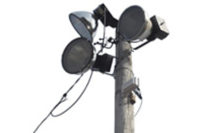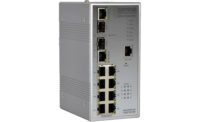Once simply a dream of sending data through the air, wireless has become a must-have in our everyday lives. And as we rely more and more on the technology and the concept, people have become much more comfortable with transmitting their surveillance video through the air as well.
The technology at the heart of this growing transmission method is wireless Ethernet radios, which do the physical work of taking the video from camera to head end across larger distances, in some cases several miles. The goal is to get video from point A to point B as quickly as possible with the least amount of disruption, distortion or loss. In security, snags can literally mean the difference between life and death, so how can security integrators make sure they’re doing the absolute best at delivering on this goal?
“In the wireless world, it’s not the easiest thing to do and it’s gotten more and more difficult as resolutions and frame rates have continued to climb, both of which have a direct impact on data rate,” says Matt Nelson, president and CEO, AvaLAN Wireless, Huntsville, Ala.
What's the Frequency?
When it comes to selecting and installing these technologies, the primary decision security integrators have to make — and the one that could have the greatest impact on video delivery — is what frequency the equipment transmits on.
The wireless Ethernet radio market is primarily separated into frequencies. There is the 5.8 GHz spectrum, which is what most Wi-Fi networks operate on, modified for outdoor use. Other frequencies include 4.9 GHz (municipally licensable) spectrum and much higher ranges that go from 60 to 80 GHz. Of these, the most common is 5.8 GHz, which can cause issues, particularly in an indoor application.
“Many of the folks in the IT world actually map out their spectrum use for their buildings or their facilities,” Nelson says. “The reason why they do that is because all of these networks are sharing a piece of the spectrum. So for instance if you have 10 cameras on a 100-megabit link, you can figure that if nobody else is using that spectrum, you’re going to have 10 megabits per camera. If you add a couple hundred people in the building all running on the same frequency you’re trying to run your cameras, you’re going to run into issues.”
For municipal applications — the semi-private spectrum used by fire, police, schools and other municipal entities — the 4.9 GHz spectrum is the way to go because there is less traffic at that frequency.
“The nice thing about that is that it’s municipally licensable so it’s not considered public spectrum,” Nelson says.
When working within the sometimes crowded 5.8 GHz spectrum, it’s important to look for radios that are designed to make the most of that frequency without disruptions.
“We use a TDMA scheme in terms of our protocol,” Nelson says. “It’s really designed for robustness and reliability and not dropping packets. As soon as you get into the video world, the last thing you want is for the video to drop out here or drop out there. You want it to be a nice constant, continuous stream. We’ve tailored our protocol to be able to fit that.”
There are some fundamental differences between the various frequencies, the main one being range.
“When you’re at the lower frequency, you can generally go much further — four or five miles with no problem — if that’s what you needed to do; whereas with the higher frequencies, you’re typically talking about a mile,” says David Sumi, vice president of marketing, Siklu, Fort Lee, N.J.
However, this has become less of a differentiator in real-world situations in recent years.
“The biggest strength that the lower frequencies had was range, but what we’re seeing is that nobody wants the video camera to be five miles away,” Sumi says. “When it’s deployed in an urban environment or suburban environment, the link from the camera to the Internet is typically a half a mile or less. So that restriction or that lack at the high frequency isn’t as important as it used to be. That’s why I think you’re seeing a lot more talk about wireless video at these higher frequencies than ever before.”
The other differences between the technologies is that there is more spectrum available at the higher frequency, which can allow you to install more radios and deliver more gigabits and higher frame rates.
“Most of what you see in the industry today has historically been done at 5 GHz but people are moving to that higher spectrum because of interference,” Sumi says. “They’re also moving to the higher frequency because of the cameras themselves. Three or five years ago, I could do a 2 MB link and that would be great for the cameras. These HD and now 4K cameras are driving 20, 30, 40 MB per second connections. That’s a high data rate and that higher frequency can do more of those higher data rates.”
The best news is that higher-frequency transmission, which has long been cost-prohibitive for most applications, could become more attainable for a wider variety of end users and see more widespread adoption, thanks to a universal truth about technology in general, Sumi says.
“In the past, there was no mass production of components inside the boxes at those frequencies, so the boxes were very expensive,” he explains. “In the last three to five years, prices have come down by a factor of five or more. That’s partly due to the fact that there’s a 60 GHz Wi-Fi standard now. That brings volume to the components and brings people into the ecosystem; so the prices for the equipment at those higher frequencies have dropped dramatically in the last couple years.”
The main application for wireless Ethernet radios is where cameras are placed in difficult-to-reach locations. These are typically outdoor applications where there may be power but not data connectivity.
“You can use these solutions in the indoor market but you’ve got the potential bandwidth issue you’d run into,” Nelson says. “For years, we’ve said, ‘If you can get a wire to it, get a wire to it.’ But if you can’t get a wire to it or it’s going to be cost-prohibitive to do so, then do wireless. It works great.”
A growing application for Ethernet radios is in the move to smart cities, which still have some way to go before they are a reality.
“The smart city applications these type of technologies focus on are public Wi-Fi backhaul, video security and connecting a municipal network — connecting police and fire and city hall,” Sumi says. “So a city will put up a network that will connect all their stuff but can also run video security at intersections or wherever you want camera and it can also run public W-Fi backhaul.”
High-speed, high-bandwidth wireless surveillance applications could become even more widespread thanks to another application for the technology. In many cities, carriers have been working to deliver gigabit connectivity to homes and businesses throughout a city, for which 5G fixed wireless has been helpful.
“Bringing fiber to the front door is fairly difficult and expensive,” Sumi says. “So what they do is bring fiber to a neighborhood, then get to the finish line with wireless.”
But while there may be sweet spots for these technologies, the sky is really the limit for determining when and where to deploy wireless radios for video transmission.
“It could be a connection between two buildings or within a campus, connecting a remote camera, etc.,” says Larry Heisler, director of marketing, Anixter, Glenview, Ill. “It could also be used as a redundant link to a physical connection as well as a backhaul solution.”
The first thing for security integrators to know about working with wireless Ethernet radios is the importance of configuration. Many manufacturers are happy to work with integrators on designing systems to maximize their effectiveness.
“It comes down to maximizing your bandwidth per camera and then mapping out how it actually works in terms of utilization of the spectrum and utilization of the network you’re trying to put together,” Nelson says. “You really need to understand those components. If it’s simply going from the NVR to three or four cameras, you don’t have to worry too much. It’s typically when you get into a larger configuration when you need to map out access points to serve certain cameras, making sure the spectrum is balanced and the network performance is balanced.”
To that end, an investment in IT know-how will pay off in the end.
“For most integrators it would be well worth their while to invest in networking knowledge,” Nelson says. “Some have a lot of experience with it and some don’t, but routing of IP information and understanding how things work in a switch and how things go through a router and how remote access to a recorder works — all those sorts of things are important.”
Another big factor is to consider the intended lifespan and performance requirements of any installed equipment.
“[Integrators] really want to make sure whatever they install is going to last several years,” Sumi says. “First of all, it has to be ruggedized; it has to be able to handle the moisture and temperature range an outdoor system [needs] to survive. It should also be in a band where you know the interference is not going to wipe you out a year from now.”
The importance of familiarity with particular products cannot be understated, Heisler says. “Go through the certification process to learn the best way to deploy the manufacturer’s solution,” he recommends. n
The Low-Cost Factor
As products become commoditized, even at the higher frequencies, it’s important to remember the old adage that you get what you pay for, says Siklu’s David Sumi.
“There are wireless radios available for less than $100,” he says. “I can put a link together and back that camera up for $200. I can get that camera connected over maybe half a mile. It sounds really good but those $200 boxes are not rated for water and they’re not rated for temperature. “They’re consumer-grade components and they’re not designed for quality. They’re designed to be as cheap as possible.”
Because they are not ruggedized, these radios, he adds, typically fail within 12 months, meaning an integrator will have to return relatively quickly to replace the failed box, which isn’t ideal when security and public safety are at stake.
“There’s a lure to go for that cheap box and there are a dozen vendors out there today with names you’ve never heard of who are selling really a low-end box,” Sumi says. “That’s a great idea to use to connect something else, but for video security you want to be very careful about the quality of the device. Video security is a public safety application so it’s not the place to be taking chances and cutting corners.”
If you use a cheap radio to connect Internet to users’ homes and that radio breaks, they won’t have Internet for a day or two. That’s not ideal, but it’s not threatening. Losing a video camera, on the other hand, could be catastrophic.
“The bomber they caught in Times Square a few years ago was caught on a camera that was connected wirelessly,” Sumi says. “If that camera had been down because the radio was low quality, they never would have caught that guy. Cities can be liable for video cameras that go down.”



